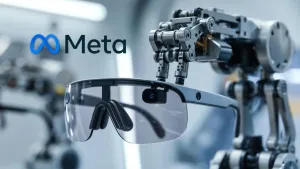Flexion Robotics announced a $50 million raise to accelerate development of its AI platform designed to control humanoid robots at industrial scale. The round was led by prominent venture investors and positions Flexion as a supplier of an intelligence layer rather than a robot manufacturer.
The company describes its core product as a system that allows full-body humanoids from different vendors to learn, adapt and perform tasks in real environments.
The announcement follows a period where robotics and AI companies have increased focus on humanoids in factories, logistics and service operations.
Flexion’s approach targets a gap in the market, most humanoid companies build hardware and custom control stacks independently, leaving no unified “brain” layer that can run across multiple robot bodies.
What Flexion Is Building
Flexion is developing a large-scale control model that uses deep learning, real-world demonstrations and simulation data to create a generalizable behavior system for humanoids.
According to the company, its platform interprets sensory feedback, balances the robot’s body, carries out manipulation tasks and manages long-horizon workflows without requiring robot makers to build these systems from scratch.
The company says this will allow factory operators and robotics firms to deploy humanoids without retraining them for each new setting. Its focus lies in creating a model that works across robots with different limb designs, actuators and sensors, which is a central technical challenge in the humanoid sector.
Humanoid robotics has gained momentum in the last two years as advances in AI, mechanical efficiency and battery systems improved feasibility.
Companies like Figure, Tesla, Sanctuary and Agility Robotics are pursuing full-body systems for industrial use. Most of these firms, however, manage hardware and intelligence in a vertically integrated pipeline.
Flexion enters the field as a horizontal provider. Instead of manufacturing robots, it aims to supply a shared intelligence layer similar to an operating system for humanoids. This mirrors how some firms in the autonomous-vehicle sector separated hardware from self-driving software.
If successful, Flexion could become a core supplier for factories that plan multi-vendor fleets of humanoids.
Funding Matters
The size of the round signals investor interest in AI systems that can support robotics rollouts at scale. Flexion plans to use the capital to expand its engineering teams, grow its demonstration datasets and advance real-world deployments with early partners.
The company also hinted at upcoming pilot programmes that test its control model in manufacturing environments.
A general intelligence layer for humanoids could reduce integration costs for enterprises. Rather than building software modules for balance, grasping, navigation and task planning separately, operators may rely on Flexion’s system as a complete control foundation.
Challenges Ahead
Flexion still needs to prove how well its platform performs across hardware from different manufacturers. Real-world robotics requires consistency across varied lighting, terrain, object types and unexpected conditions. Safety, latency and reliability will all factor into how ready Flexion’s model is for factory or logistics deployment.
The company will also face competition from firms that integrate AI directly into their humanoid platforms. If hardware-plus-software makers move quickly, Flexion must demonstrate that a shared intelligence layer can outperform closed systems.
Flexion may plans to reveal more details on partner robots, pilot sites and early production runs in the coming months. The next updates will show whether its platform can scale beyond lab settings and whether customers adopt a model built to support fleets of humanoids across industries.
Conclusion
Flexion’s raise positions the company as a new player in the emerging market for humanoid intelligence platforms. By focusing on a generalizable control system rather than hardware, it attempts to fill a technical and commercial gap in the robotics ecosystem.
The next phase will determine whether its approach can anchor real industrial deployments as humanoid adoption accelerates.





